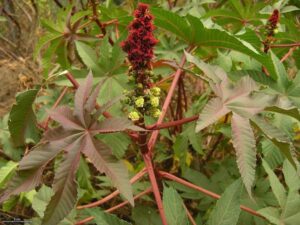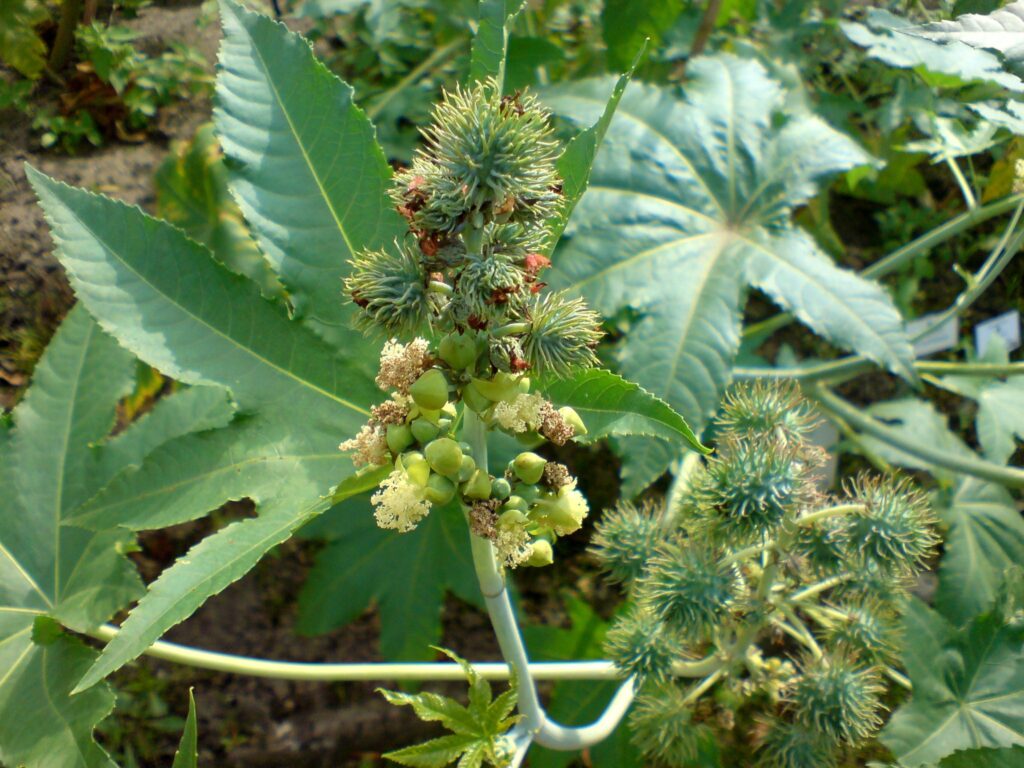Herb
Eranda (Ricinus communis) Herb Ayurvedic Overview
Eranda consists of dried and mature roots of Ricinus communis Linn. (Fam. Euphorbiaceae). It is a tall, glabrous shrub and an almost small tree 2-4 m high. The plant is evergreen and semi-woody. The stems contain a hollow node and are green to reddish. The flat seeds are in seedpod, and they explode when ripe. It can be grown at high altitudes up to 2000 meters and intact perennial types. The plant is generally grown on sandy or clay of deep red loams.
The plant is reported to possess antioxidant, anti-inflammatory, antidiabetic, antitumor, and anti-asthmatic properties and is used for many years in managing various health conditions. Eranda effectively works in chronic fever, piles, skin diseases, rheumatoid arthritis, digestion-related issues, lymphadenitis, Irritable bowel syndrome, etc.
Table of Contents
Scientific Classification of Eranda (Ricinus communis):
- Kingdom: Plantae
- Phylum: Spermatophyta
- Subphylum: Angiospermae
- Class: Dicotyledonae
- Order: Euphorbiales
- Family: Euphorbiaceae
- Genus: Ricinus
- Species: Ricinus communis
Eranda (Ricinus communis) Synonyms:
- Sanskrit: Gandharvahasta, Vatari, Rubu, Pancangula
- Assamese: Eda, Era
- Bengali: Bherenda
- English: Castor oil plant
- Gujrati: Erandio, Erando
- Hindi: Arand, Erand, Andi, Rend
- Kannada: Haralu, Oudala gida
- Kashmiri: Aran, Banangir
- Malayalam: Avanakku
- Marathi: Erand
- Oriya: Jada, Gaba
- Punjabi: Arind
- Tamil: Amanakku
- Telugu: Amudapu veru
- Urdu: Bedanjir, Arand
Eranda (Ricinus communis) Description:
 a) Macroscopic: The roots of Eranda are light in weight and are almost straight. The outer surface is dull yellowish-brown, nearly smooth but marked with longitudinal wrinkles, and in some places, it is whitish-yellow and soft, odorless, taste, acrid. The seeds are oblong, having 1-1.5 cm long, smooth, hard mottled crustaceous testa.
a) Macroscopic: The roots of Eranda are light in weight and are almost straight. The outer surface is dull yellowish-brown, nearly smooth but marked with longitudinal wrinkles, and in some places, it is whitish-yellow and soft, odorless, taste, acrid. The seeds are oblong, having 1-1.5 cm long, smooth, hard mottled crustaceous testa.
b) Microscopic: The Transverse section of the Eranda (Ricinus communis) root shows a skinny layer of cork of squares to tangentially elongated walled cells. Beneath cork, the thin-walled secondary cortex is the narrow cortex and is rounded to elongate thin-walled parenchymatous cells tangentially. Some containing rosettes of calcium oxalate crystals, large oil globules, and round simple or compound starch grains.
Phloem is consisting of sieve tubes, phloem parenchyma, and phloem fibers. Its fibers are long, primarily septate, highly thickened, and is having a narrow lumen. Some threads are surrounded by concentric rows of cells containing crystals of calcium oxalate, sieve tubes, thin-walled companion cells, and phloem parenchyma in the inner region of the phloem. The parenchyma cells contain cambium 3-5 layered and crystals of calcium oxalate. The xylem occupies the central part of the root, vessels, fibers, and parenchyma. The vessels are uniformly scattered throughout the xylem region, more significant in size towards phloem with bordered pits. Xylem parenchyma is less in number and contains starch grains, thick-walled, sometimes found near the protoxylem group.
Identity, Purity, and Strength of Eranda (Ricinus communis):
- Foreign matter Not more than 2 percent, Appendix 2.2.2.
- Total Ash Not more than 8 percent, Appendix 2.2.3.
- Acid-insoluble ash Not more than 1 percent, Appendix 2.2.4.
- Alcohol-soluble extractive Not less than 3 percent, Appendix 2.2.6.
- Water-soluble extractive Not less than 9 percent, Appendix 2.2.7.
Chemical Constituents of Eranda (Ricinus communis):
Chemical constituents of Eranda are steroids, flavonoids, saponins, glycosides, and alkaloids. Other than these, there is Gallic acid; quercetin; gentisic acid, rutin, epicatechin, and ellagic acid that are primary phenolic compound isolated from leaves.
Ayurvedic Properties and Action of Eranda (Ricinus communis):
- Rasa: Madhura
- Guna: Guru, Snigdha
- Virya: Ushna
- Vipaka: Madhura
- Karma: Vataghana, Aampachak, Varishya, Shwasahara, Gulamhara, Shwasahara, Shoolaghana, Pleehaghan, Shoshahara, Kapha shamak, Mutrakrich,
Ayurvedic Formulation made by Eranda (Ricinus communis):
The Ayurvedic Formulation of Ricinus communis is Vishagarbha taila, Maharasnadi Kwath, Chaturmukha rasa, Eranda Paka, Gandharvahasthadi Kshayam.
Therapeutic Uses of Eranda (Ricinus communis):
The main indications of Eranda (Ricinus communis) are Udarroga, Amavata, Jwara, Shoth, Krimihara, Keshaya, Gulamhara, Vranahara, Vardhamahara, etc.
Dose of Eranda (Ricinus communis):
20-30 g of the drug for decoction.
Reference:
Ayurvedic Pharmacopeia of India.


